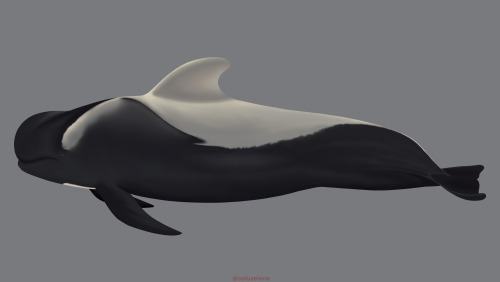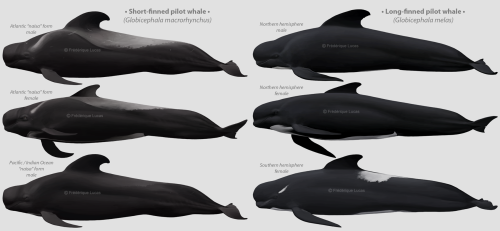#pilot whale
A plethora of pilot whales
The alliterations continue, as well as the uploading of illustrations from last year’s two big project. This time, pilot whales. A big and impressive relative of the killer whale, which come in two species: the Long-finned (Globicephala melas) and Short-finned (Globicephala macrorhynchus). Ironically pectoral fin length isn’t always a good identifier, but shape is a good call: in Short-fins the pectoral fins have a continuous sickle shape, whereas in Long-fins the pectoral fins have a single bend, and then taper out very straight.
Within the species there is diversity too. Long-finned pilot whales are the colder water species of the two, and thus their range is divided into a northern and southern population. Northern animals are quite plain black aside from the white anchor marking on their chest and belly. However Southern animals bear very striking white eye- and saddle patches, a bit reminiscent of killer whales.
Short-finned pilot whales live in warmer waters and Japanese fishermen had long known of two different types. Recent research showed these to be two distinct global subspecies: the “Shiho” form, living mostly in the Eastern Pacific but also off Northern Japan, and the “Naisa” form, living in the rest of the Pacific Ocean, as well as the Indian and Atlantic. They can be told apart by their saddle patch: the Naisa form has a long saddle patch reaching almost the end of the peduncle, whereas the Shiho form has a very short one. I only illustrated Naisa animals, but all pilot whales currently living at Seaworld are of the Shiho form and you can see the difference in saddle patch length.
Within the Naisa form there’s yet more differences. In the Pacific and Indian Ocean, Naisa’s have very muted colouration, as shown by the bottom illustration. It can be hard to even spot their saddle patches at all! However Atlantic animals are very brightly coloured with beautiful creamy markings sweeping up from behind their eye and into their prominent saddle patches.
Post link



